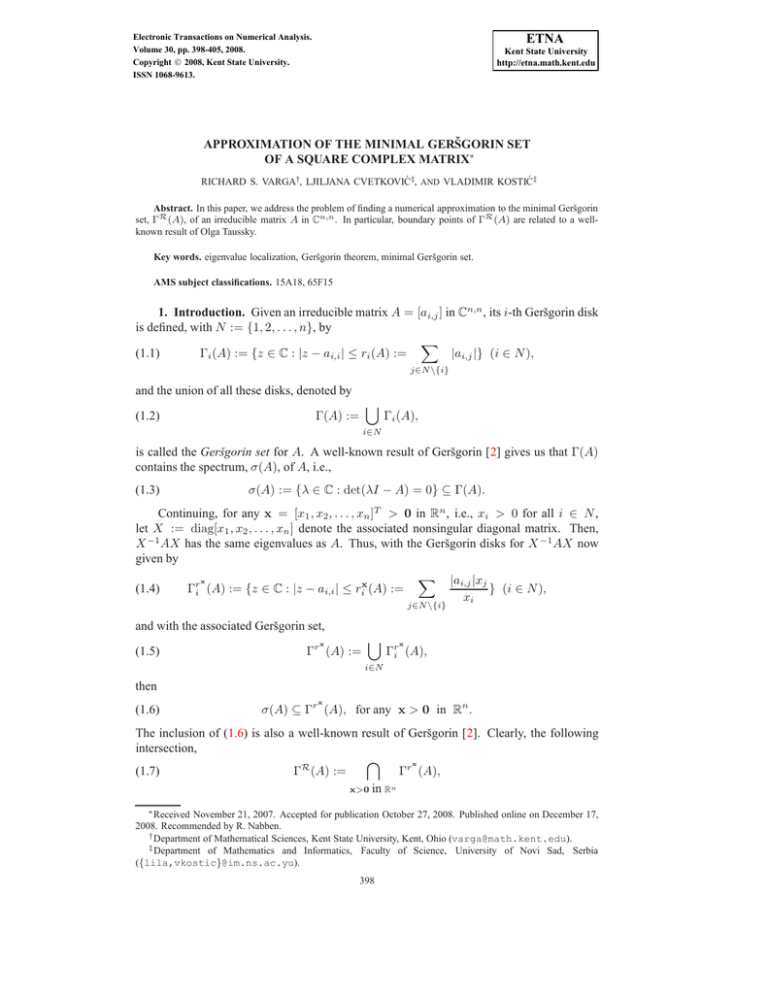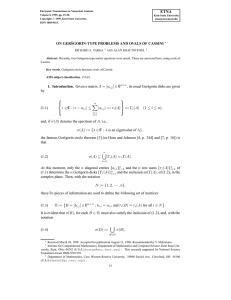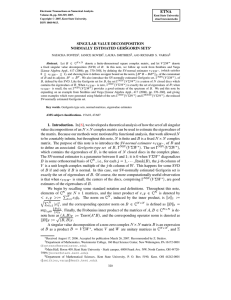ETNA
advertisement

ETNA
Electronic Transactions on Numerical Analysis.
Volume 30, pp. 398-405, 2008.
Copyright 2008, Kent State University.
ISSN 1068-9613.
Kent State University
http://etna.math.kent.edu
APPROXIMATION OF THE MINIMAL GERŠGORIN SET
OF A SQUARE COMPLEX MATRIX∗
RICHARD S. VARGA†, LJILJANA CVETKOVIƇ, AND VLADIMIR KOSTIƇ
Abstract. In this paper, we address the problem of finding a numerical approximation to the minimal Geršgorin
set, ΓR (A), of an irreducible matrix A in Cn,n . In particular, boundary points of ΓR (A) are related to a wellknown result of Olga Taussky.
Key words. eigenvalue localization, Geršgorin theorem, minimal Geršgorin set.
AMS subject classifications. 15A18, 65F15
1. Introduction. Given an irreducible matrix A = [ai,j ] in Cn,n , its i-th Geršgorin disk
is defined, with N := {1, 2, . . . , n}, by
X
|ai,j |} (i ∈ N ),
(1.1)
Γi (A) := {z ∈ C : |z − ai,i | ≤ ri (A) :=
j∈N \{i}
and the union of all these disks, denoted by
(1.2)
[
Γ(A) :=
Γi (A),
i∈N
is called the Geršgorin set for A. A well-known result of Geršgorin [2] gives us that Γ(A)
contains the spectrum, σ(A), of A, i.e.,
(1.3)
σ(A) := {λ ∈ C : det(λI − A) = 0} ⊆ Γ(A).
Continuing, for any x = [x1 , x2 , . . . , xn ]T > 0 in Rn , i.e., xi > 0 for all i ∈ N ,
let X := diag[x1 , x2 , . . . , xn ] denote the associated nonsingular diagonal matrix. Then,
X −1 AX has the same eigenvalues as A. Thus, with the Geršgorin disks for X −1 AX now
given by
X |ai,j |xj
x
(1.4)
Γri (A) := {z ∈ C : |z − ai,i | ≤ rix (A) :=
} (i ∈ N ),
xi
j∈N \{i}
and with the associated Geršgorin set,
(1.5)
x
Γr (A) :=
[
x
Γri (A),
i∈N
then
(1.6)
x
σ(A) ⊆ Γr (A), for any x > 0 in Rn .
The inclusion of (1.6) is also a well-known result of Geršgorin [2]. Clearly, the following
intersection,
\
x
Γr (A),
(1.7)
ΓR (A) :=
x>0 in Rn
∗ Received November 21, 2007. Accepted for publication October 27, 2008. Published online on December 17,
2008. Recommended by R. Nabben.
† Department of Mathematical Sciences, Kent State University, Kent, Ohio (varga@math.kent.edu).
‡ Department of Mathematics and Informatics, Faculty of Science, University of Novi Sad, Serbia
({lila,vkostic}@im.ns.ac.yu).
398
ETNA
Kent State University
http://etna.math.kent.edu
APPROXIMATION OF THE MINIMAL GERŠGORIN SET OF A SQUARE COMPLEX MATRIX
399
x
called the minimal Geršgorin set in [4, 6], is always a subset of Γr (A), for any x > 0 in
Rn , thereby giving the sharpest inclusion set for σ(A), with respect to all positive diagonal
similarity transforms X −1 AX of A.
This sharpness can also be expressed in the following way; cf. [6, Theorem 4.5]. With
(1.8)
Ω̂(A) := {B = [bi,j ] ∈ Cn,n : bi,i = ai,i and |bi,j | ≤ |ai,j | for i 6= j (i, j ∈ N )},
then
σ Ω̂(A) :=
(1.9)
[
σ(B) = ΓR (A),
B∈Ω̂(A)
i.e., each point of ΓR (A) is an eigenvalue of some matrix B in Ω̂(A).
x
Unlike the Geršgorin set Γ(A) of (1.2) or Γr (A) of (1.5), the minimal Geršgorin set
ΓR (A) of (1.7) is not in general easy to determine numerically. The aim of this paper is
to find a reasonable approximation of ΓR (A), with a finite number of calculations, which
contains ΓR (A), and for which a limited number of boundary points of this approximation
are actual boundary points of ΓR (A). The determination of these latter boundary points are
then related to a famous sharpening, by Olga Taussky [3], of the Geršgorin set of (1.2).
2. Background. Given an irreducible matrix A = [ai,j ] in Cn,n , its associated irreducible matrix Q(z) = [qi,j (z)], in Rn,n , is defined by
(2.1)
qi,i (z) := −|z − ai,i |, and qi,j (z) := |ai,j |, for i 6= j (i, j ∈ N ).
If
µ(z) := max |z − ai,i |,
(2.2)
i∈N
then the matrix B(z) := [bi,j (z)] ∈ Rn,n , defined by
(2.3)
bi,i (z) := µ(z) − |z − ai,i |, and bi,j (z) := |ai,j |, i 6= j (i, j ∈ N ),
satisfies
B(z) = Q(z) + µ(z)In ,
(2.4)
where B(z) is a nonnegative irreducible matrix in Rn,n . Then, from the Perron-Frobenius
theory of nonnegative matrices, the matrix B(z) possesses a positive real eigenvalue, ρ(B(z)),
called the Perron root of B(z), which is characterized as follows. For any x > 0 in Rn,n ,
either
(2.5)
min{ B(z)x i /xi } < ρ(B(z)) < max{ B(z)x i /xi },
i∈N
i∈N
or
B(z)x = ρ(B(z))x.
(2.6)
Thus, if we set
ν(z) := ρ(B(z)) − µ(z) (all z ∈ C),
(2.7)
then ν(z) is a real-valued function, defined for all z ∈ C. Moreover, from (2.5) and (2.6), for
any x > 0 in Rn and any z ∈ C, either
(2.8)
min{ Q(z)x i /xi } < ν(z) < max{ Q(z)x i /xi },
i∈N
i∈N
ETNA
Kent State University
http://etna.math.kent.edu
400
R. VARGA, L. CVETKOVIĆ, AND V. KOSTIĆ
or
(2.9)
Q(z)x = ν(z)x,
the last equation giving us that ν(z) is an eigenvalue of Q(z).
The following connection of the function ν(z) of (2.7) to the minimal Geršgorin set,
ΓR (A), comes from [4] and [6]:
(2.10)
z ∈ ΓR (A) if and only if ν(z) ≥ 0,
and
(2.11)
if z ∈ ∂ΓR (A), then ν(z) = 0.
It is also known (cf. [6], Theorem 4.6), from the assumption that A is irreducible, that
(2.12)
ν(ai,i ) > 0, for all i ∈ N.
Further, given any real number θ with 0 ≤ θ < 2π, it is known (cf. [6], Theorem 4.6) that
there is a largest number ̺ˆi (θ) > 0 such that
(2.13)
ν(ai,i + ̺ˆi (θ)eiθ ) = 0, and ν(ai,i + teiθ ) ≥ 0, for all 0 ≤ t < ̺ˆi (θ),
̺ˆ (θ)
i
lies in ΓR (A). This implies that the set
so that the entire complex interval [ai,i + teiθ ]t=0
(2.14)
2π
[
̺ˆ (θ)
i
[ai,i + teiθ ]t=0
θ=0
is a star-shaped subset of ΓR (A), for each i ∈ N , with
(2.15)
ν(ai,i + ̺ˆi (θ)eiθ ) ∈ ∂ΓR (A).
The results of (2.14) and (2.15) will be used below.
Next, we recall the famous result of Olga Taussky [3], on a sharpening of the Geršgorin
Circle Theorem: Let A = [ai,j ] in Cn,n be irreducible. If λ ∈ σ(A) is such that
λ∈
/ int Γi (A) for each i ∈ N , i.e., |λ − ai,i | ≥ ri (A) for each i ∈ N , then
(2.16)
|λ − ai,i | = ri (A), for each i ∈ N,
i.e., each Geršgorin circle {z ∈ C : |z − ai,i | = ri (A)} passes through λ.
To complete this section, we include the following:
(2.17)
If ν(z) = 0, then det Q(z) = 0.
This follows directly from (2.9), since ν(z) is an eigenvalue of Q(z). Finally, from [6, Exercise 7, p. 108], we also have that
(2.18)
for any z and z ′ in C, |ν(z) − ν(z ′ )| ≤ |z − z ′ |,
so that ν(z) is uniformly continuous in C. This also will be used below.
ETNA
Kent State University
http://etna.math.kent.edu
APPROXIMATION OF THE MINIMAL GERŠGORIN SET OF A SQUARE COMPLEX MATRIX
401
3. Numerical procedure for approximating ΓR (A). With the given irreducible matrix
A = [aij ] in Cn,n , choose any j in N , and set z = aj,j . Next, we assume that the nonnegative
irreducible matrix B(aj,j ), which has at least one zero diagonal entry from (2.3), is a primitive
matrix; cf. of [5, Section 2.2]. (We note that this is certainly the case if some diagonal entry
of B(aj,j ) is positive. More generally, if B(aj,j ) is not primitive (i.e., B(aj,j ) is cyclic of
some index p ≥ 2), then any simple shift of B(aj,j ) into B(aj,j ) + εIn is primitive for each
ε > 0.)
With B(aj,j ) primitive, then, starting with an x(0) > 0 in Rn , the power method gives
convergent upper and lower estimates for ρ(B(aj,j )), i.e., if x(m) := B m (aj,j )x(0) for all
(m)
(m)
(m)
m ≥ 1, then with x(m) := [x1 , x2 , ..., xn ]T , we have
(m+1)
(3.1)
λm := min{
i∈N
xi
(m)
xi
(m+1)
} ≤ ρ(B(aj,j )) ≤ max{
i∈N
xi
(m)
xi
} =: λm
for all m ≥ 1, with
(3.2)
lim λm = ρ(B(aj,j )) = lim λm .
m→∞
m→∞
In this way, using (2.4), (2.7), and (2.9), convergent upper and lower estimates of ν(aj,j )
can be numerically obtained. (These estimations of ν(aj,j ) do not need great accuracy for
graphing purposes, as the example in Section 4 shows).
Next, assume, for convenience, that ν(aj,j ) > 0 is accurately known, and select any real
θ, with 0 ≤ θ < 2π. The numerical goal now is to estimate the largest ̺ˆj (θ), with sufficient
accuracy, where, from (2.2),
(3.3)
ν(aj,j + ̺ˆj (θ)eiθ ) = 0, with ν(aj,j + (ˆ
̺j (θ) + ε)eiθ ) < 0
for all sufficiently small ε > 0. By definition, we then have that
(3.4)
aj,j + ̺ˆj (θ)eiθ is a boundary point of ΓR (A).
This means, from the min-max conditions (2.8)-(2.9), that there is an x > 0, in Rn , such
that (cf. (2.9))
(3.5)
Q(aj,j + ̺ˆj (θ)eiθ )x = 0, where x = [x1 , x2 , ..., xn ]T > 0.
Equivalently, on calling aj,j + ̺ˆj (θ)eiθ =: zj (θ), we can express (3.5), using the definition
of (2.1), as
X
|ai,k |xk /xi , (all i ∈ N ),
(3.6)
|zj (θ) − ai,i | =
k∈N \{i}
which can be interpreted, from (2.16), simply as Olga Taussky’s boundary result. What is
perhaps more interesting is that it is geometrically unnecessary now to determine the components of the vector x > 0 in Rn , for which (3.6) is valid. This follows since knowing the
boundary point zj (θ) of ΓR (A), and knowing each of the centers, {ai,i }i∈N , of the associated n Geršgorin disks, then all the circles of (3.6) can be directly drawn, without knowing
the components of the vector x.
ETNA
Kent State University
http://etna.math.kent.edu
402
R. VARGA, L. CVETKOVIĆ, AND V. KOSTIĆ
We return to the numerical estimation of ̺ˆj (θ), which satisfies (3.3)-(3.5). Setting
z := aj,j and z ′ := aj,j + ̺ˆj (θ)eiθ , we know from (2.18) that
̺ˆj (θ) ≥ ν(aj,j ) > 0.
(3.7)
Consider then the number ν(aj,j + ν(aj,j )eiθ ). If this number is positive, then increase the
number ν(aj,j ) to ν(aj,j ) + ∆, ∆ > 0, until ν(aj,j + (ν(aj,j ) + ∆)eiθ ) is negative, and apply
a bisection search to the interval [ν(aj,j ), ν(aj,j ) + ∆] to determine ̺ˆj (θ), satisfying (3.3).
(Again, as in the estimation of ν(aj,j ), estimates of ̺ˆj (θ) do not need great accuracy for
graphing purposes.) We remark that a similar bisection search, on z, can be directly applied
to
(3.8)
det Q ν(aj,j + ̺ˆj (θ)eiθ ) = 0,
as a consequence of (2.11) and (2.15), but this requires, however, the evaluation of an n × n
determinant.
To summarize, given an irreducible matrix A = [ai,j ] in Cn,n , our procedure for approximating its minimal Geršgorin set, ΓR (A), is to first determine, with reasonable accuracy, the
positive numbers {ν(aj,j )}j∈N , and then, again with reasonable accuracy, to determine a few
R
R
boundary points {ωk }m
k=1 of Γ (A). For each such boundary point ωk of Γ (A), there is an
associated Geršgorin set, consisting of the union of the n Geršgorin disks, namely,
[
(3.9)
Γωk (A) :=
{z ∈ C : |z − ai,i | ≤ |ωk − ai,i |},
i∈N
and their intersection,
m
\
(3.10)
Γωk (A),
k=1
gives an approximation
to ΓR (A), for which ΓR (A) is a subset, and for which m points, of
Tm
the boundary of k=1 Γωk (A), are boundary points of ΓR (A).
4. An easy example. Consider the irreducible 3 × 3 matrix
2 0 1
(4.1)
C = 0 1 1 ,
1 1 2
whose minimal Geršgorin set, ΓR (C), is shown with the inner blue boundary in Figure 4.1.
(This minimal Geršgorin set, ΓR (C), also appears as the set with boundary (1) (2) (3) of [6,
x0
Figure 4.4].) For the vector x0 = [1, 1, 1]T ∈ R3 , the associated Geršgorin set Γr (C),
turns out to be simply
(4.2)
x0
Γr (C) = {z ∈ C : |z − 2| ≤ 2}.
The boundary of this set is the (outer) black circle in Figure 4.1.
Next, starting with the diagonal entry, z = 2, of the matrix C, we estimate ν(2), which is
positive from (2.12). As µ(2) = 1 from (2.2), the associated nonnegative irreducible matrix
B(2) from (2.3) is
1 0 1
B(2) = 0 0 1 ,
1 1 1
ETNA
Kent State University
http://etna.math.kent.edu
APPROXIMATION OF THE MINIMAL GERŠGORIN SET OF A SQUARE COMPLEX MATRIX
403
F IG . 4.1.
and a few power method iterations (see (3.1)-(3.2)), starting with x0 = [2, 1, 2]T , gives that
.
ρ(B(2)) = 2.2. More precisely1 , ρ(B(2)) = 2.24697, so that from (2.7) we have ν(2) =
1.24697.
Next, we search on the ray 2 + t, with t ≥ 0, for the largest value t̂ for which ν(2 + t̂) =
0 and ν(2 + t) ≥ 0 for all 0 ≤ t ≤ t̂. Using the inequality of (2.18), it follows that
t̂ ≥ ν(2) = 1.24697. However, in this particular case, it happens that t̂ = 1.24697, so that
z1 = 3.24697 is such that ν(z1 ) = 0, with z1 ∈ ∂ΓR (C). Similarly, on considering the
diagonal entry 1 = c2,2 , we approximate ν(1), which turns out to be ν(1) = 0.80194, and
then searching on the ray 1 − t, t ≥ 0, we similarly obtain ν(z2 ) = 0 with z2 = 0.19806,
x
x
and with z2 ∈ ∂ΓR (C). Calling Γr1 (C) and Γr2 (C) the associated Geršgorin sets, then the
T2
x
intersection of the three sets, j=0 Γrj (C), is shown in Figure 4.1 with the red boundary,
where the boundary of the minimal Geršgorin set, ΓR (C), is shown in blue.
We see from Figure 4.1 that the set with the red boundary is a set in the complex plane
which contains ΓR (C) and has two real boundary points, shown as the black squares z1 and
z2 , in common with ΓR (C). Continuing, knowing ν(a1,1 = a3,3 = 2) = 1.24697 and
ν(a2,2 = 1) = 0.80194, we then look for four additional points of ∂ΓR (C) which are found
on the four rays: 2 ± it, t ≥ 0, and 1 ± it, t ≥ 0. This gives us the following four points
{zj }6j=3 of ΓR (C):
z3 = 1 + i(1.150963), z4 = z3 , z5 = 2 + i(1.34236), z6 = z5 .
The intersection now of the above associated six Geršgorin sets is shown in Figure 4.1 with
the green boundary, which includes ΓR (C) and has six boundary points in common with
∂ΓR (C), shown as solid black squares. The region between the green boundary of ΓR (C)
and its blue boundary is colored in yellow, which can be seen as small “roofs” composed of
segments of circular arcs.
The amount of numerical calculation to obtain a good approximation to ΓR (C) is moderate. It is further evident that better approximations to ΓR (C), having more points in common
with ∂ΓR (C), can be similarly constructed.
5. Comparisons with Brualdi sets. Given an irreducible matrix A = [aij ] in Cn,n ,
n ≥ 2, one can similarly associate with A a minimal Brauer set, KR (A), as well as a minimal
1 All
such numbers are truncated after five decimal digits.
ETNA
Kent State University
http://etna.math.kent.edu
404
R. VARGA, L. CVETKOVIĆ, AND V. KOSTIĆ
Brualdi set B R (A), as described in [6, Section 4.3]. However, it is known (see [6, Theorem
4.15]) that all of these sets are equal, i.e.,
ΓR (A) = KR (A) = B R (A),
(5.1)
but the approximation of, say, the minimal Brualdi set B R (A), would now differ from our
approximations of the minimal Geršgorin set, ΓR (A), described earlier in this paper. For
matrices having a very large number of nonzero off-diagonal entries, it is unlikely (see [6,
Section 2.3]) that a similar numerical approximation of the minimal Brualdi set, B R (A),
which from (5.1) equals ΓR (A), would be numerically competitive with our numerical approach of Section 3 for approximating ΓR (A). But, in the case of the matrix C of (4.1),
there are just two associated Brualdi cycles, γ1 = (13) and γ2 = (23), for this matrix C, so
that the approximation of ΓR (C), via Brualdi sets, in this case, is easy. In particular, for any
x = [x1 , x2 , x3 ]T > 0 in R3 , its associated Brualdi lemniscates (cf. [6, eq. (4.78)]) are
(5.2)
Bγr1 (C) = {z ∈ C : |z − 2|2 ≤ r1x (C) · r2x (C) =
x
x3 x1 + x2 x1 + x2
},
·
=
x1
x3
x1
and
(5.3)
x
Bγr2 (C) = {z ∈ C : |z − 1||z − 2| ≤
x3 x1 + x2 x1 + x2
},
·
=
x2
x3
x2
so that its associated Brualdi set is (cf. [6, eq. (2.40)])
x
x
B r (C) = Bγr1 (C)
(5.4)
[
x
Bγr2 (C).
Now, knowing that z1 = 3.24697 is a boundary point of ΓR (C), we determine x1 > 0 and
x1
x2 > 0 so that z1 = 3.24697 is a boundary point of B r (C). For this particular point
z1 = 3.24697, the associated Brualdi set, consisting of the union of two Brualdi lemniscate
sets, is such that the boundary of each Brualdi lemniscate passes through z1 . (This is exactly
the analog of Olga Taussky Theorem in the Geršgorin case; see [1] and [6, Theorem 2.8].)
The union of these two Brualdi lemniscate sets can be verified to reduce to
x1
B r (C) = {z ∈ C : |z − 1| · |z − 2| ≤ 2.80193}.
Similarly, for the point z2 = 0.19806, the associated Brualdi set has its two lemniscate sets
passing through z2 , and the union of these two Brualdi lemniscate sets can be verified to
reduce to the disk
x2
B r (C) = {z ∈ C : |z − 2| ≤ 1.80193}.
T x2
x1
The boundary of the intersection Bγr1 (C) Bγr2 (C) is shown in Figure 5.1 with the green
boundary. Also shown in Figure 5.1, with the red boundary, is the related Geršgorin set
from Figure 4.1, which also has z1 and z2 as common points with the minimal Geršgorin set
ΓR (C).
T x2
x1
From Figure 5.1, we see that Bγr1 (C) Bγr2 (C) is a proper subset of the related
Geršgorin set, where the difference between these sets is shown in yellow. This is not unexpected, as it is known (cf. [6, eq. (4.80)]) that, for any matrix A in Cn,n ,
x
x
B r (A) ⊆ Γr (A), for any x > 0 in Rn .
ETNA
Kent State University
http://etna.math.kent.edu
APPROXIMATION OF THE MINIMAL GERŠGORIN SET OF A SQUARE COMPLEX MATRIX
405
F IG . 5.1.
Acknowledgment. This work is supported by the Provincial Secretariat of Science and
Technological Development of Vojvodina, Serbia, grant 0708 and by the Ministry of Science
of Serbia, grant 144025.
REFERENCES
[1] R. B RUALDI, Matrices, eigenvalues and directed graphs, Linear Multilinear Algebra, 11 (1982), pp. 148–165.
[2] S. G ER ŠGORIN, Über die Abgrenzung der Eigenwerte einer Matrix, Izv. Akad. Nauk SSSR Ser. Mat., 1
(1931), pp. 749–754.
[3] O. TAUSSKY, Bounds for the characteristic roots of matrices, Duke Math. J., 15 (1948), pp. 1043–1044.
[4] R. S. VARGA, Minimal Geršgorin sets, Pacific J. Math., 15 (1965), pp. 719–729.
[5] R. S. VARGA, Matrix Iterative Analysis, Second revised and expanded edition, Springer, Berlin, 2000.
[6] R. S. VARGA, Geršgorin and His Circles, Springer, Berlin, 2004.


